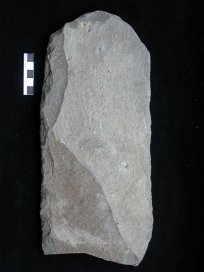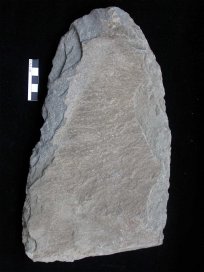Lithics
The most notable feature of Taukamayo was the relatively high density of obsidian as compared with other areas of Block 3. It appears that obsidian reduction occurred here on a number of occasions and due to the landslide, obsidian flakes appear in many parts of the slide deposition pile.
|
Taukamayo Cores - Surface |
Entire Block 3 Surface Collection |
|||||||
|
Material |
No. |
m Cortex |
mWt |
sWt |
No. |
m Cortex |
mWt |
sWt |
|
Obsidian |
10 |
25 |
14.31 |
7.8 |
17 |
5.0 |
23.2 |
13.1 |
|
Volcanics |
- |
- |
- |
- |
2 |
7.5 |
87.7 |
42.6 |
|
Chalcedony |
- |
- |
- |
- |
4 |
16.7 |
47.5 |
18.1 |
|
Chert |
1 |
0 |
34.4 |
- |
18 |
32.1 |
57.17 |
33.8 |
|
Total |
12 |
32.1 |
48.4 |
29.0 |
41 |
21.6 |
43.6 |
31.3 |
Table 6-53. Cores from the surface of Taukamayo as compared with the entire Block 3 surface collection.
Obsidian cores (all Ob1) were relatively abundant at Taukamayo but they were not exceptionally common. Nodules of black and tan colored chert were observed in the creek bed at Taukamayo and the material was being flaked elsewhere on terraces adjacent to the creek, but curiously only one core of this chert was found at Taukamayo. The distribution of obsidian material at the site suggests that a range of reduction stages on obsidian were occurring in this location and comparably less of the local chert or quartzite material was in use.
|
Ob1 |
Ob2 |
Volcanics |
Chalcedony |
Chert |
Quartzite |
Total |
|
|
Flakes |
138 |
199 |
53 |
25 |
181 |
79 |
675 |
|
Cores |
11 |
8 |
- |
2 |
4 |
1 |
26 |
|
Points & Tools |
22 |
15 |
1 |
- |
1 |
- |
40 |
|
Hoes |
- |
- |
16 |
- |
- |
- |
16 |
|
Total |
171 |
222 |
70 |
27 |
186 |
80 |
757 |
Table 6-54. Counts of lithics from surface collection at Taukamayo [A02-26].
This table shows that counts of obsidian are relatively high at Taukamayo. These counts should not be compared directly with other sites in Block 3 because these analysis results reflect two unusual aspects of Taukamayo. First, the high counts at this site are, in part, due the visibility of lithics in the debris from the landslide. Second, a detailed lithics analysis was conducted on the excavated materials from A02-26u1, as well as on surface materials from this site, and these high counts reflect this detailed analysis.
Chert and quartzite are immediately available in this area, and yet these material types are the minority in representation in flaked stone artifacts at the site. Secondly, Ob2 obsidian was relatively common at Taukamayo. As compared with the Block 2 site of Pausa (see Table 6-51 in Block 2 discussion) where obsidian use is primarily (87%) Ob1 material, at Block 3 Taukamayo there appears to be less concern for the clarity of the material or the presence of heterogeneities because 57% of the obsidian artifacts are Ob2 material. In fact, Taukamayo contains the highest proportion of bifacially flaked tools made from Ob2 material from the entire survey area. Notably, however, these were primarily bifaces not points, as only two of the artifacts made from Ob2 obsidian were projectile points.
Figure 6-66. Sixteen large andesite hoes were found at Taukamayo [A02-26].
Finally, this site contained an exceptional collection of sixteen large, broken andesite hoes. The hoes varied considerably in size, and it is difficult to assess the original, unbroken size of the items. The hoes ranged in weight from 112g to one as large as 1189g (shown in Figure 6-66, right), with a high variance. All showed signs of intial shaping with percussion flaking as well as flake scars from use. The mean weight was 512g, but with a standard deviation of 483.7.
These hoes had bifacial flaking on the working edge, and most showed polish from use, but no hafting wear was observed under visual inspection. The source of the andesite has not been determined, but if the source lies somewhere distant it is possible that, as with obsidian, Taukamayo contained a high percentage of non-local lithic materials that contrasts with neighboring sites in the area (see lithic analysis data reported in Section 7.6.1).


